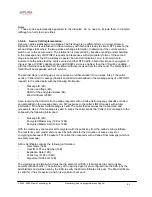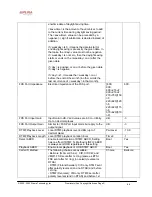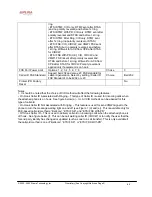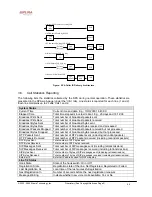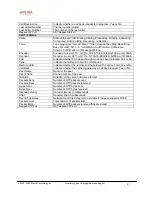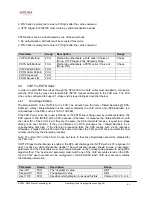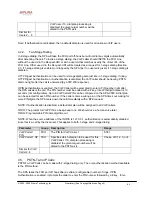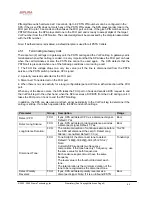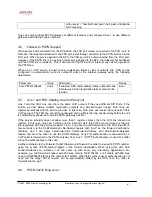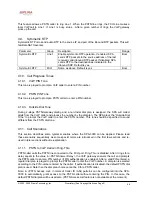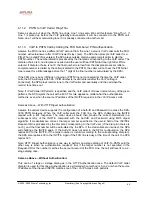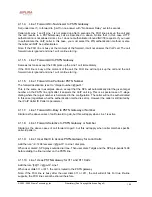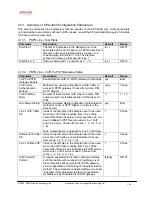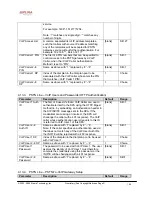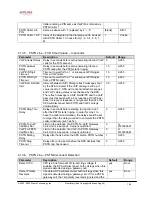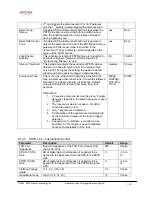
© 2003 - 2005 Sipura Technology, Inc
Proprietary (See Copyright Notice on Page 2)
99
4.11.2. PSTN to VoIP Call w/ Ring-Thru
Same as above but when the PSTN line rings, Line 1 rings also. We call this feature “Ring-Thru”. If
Line 1 is picked up before the VoIP gateway auto-answers, it will be connected to the PSTN call.
Note: Line 1 will hear call-waiting tone if it is already connected to another call.
4.11.3. VoIP to PSTN Call by Calling the FXO Number w/ PIN Authentication
Assume the FXO line has a different VoIP account from the Line 1 account. VoIP caller calls the FXO
number, will auto-answer after <VoIP Answer Delay> (sec). The SPA then prompts VoIP caller for a
PIN. When a valid PIN is entered, the SPA plays outside dial tone and prompts caller to dial the
PSTN number. The number dialed is processed by the dial plan corresponding to the VoIP caller. The
dial plan choice is 0, no dial plan is needed and the user will hear PSTN dial tone right after PIN is
entered. If dial plan choice is not 0, the final number returned from the dial plan processor (after a
complete number is dialed by the caller) is dialed to the PSTN; the caller will not hear the PSTN dial
tone (except for a little leakage before the 1
st
digit of the final number is auto-dialed by the SPA).
If the FXO Line is busy (off-hook or ringing or PSTN line not connected) at the time the VoIP caller
calls, the SPA will reply with 503. If PIN number is invalid (entered after the VoIP call leg is
connected), the SPA plays reorder tone to the VoIP caller and eventually end the call when the
reorder tone times out.
Note: If <VoIP Caller ID Pattern> is specified and the VoIP caller’s ID does not match any of the given
patterns, the SPA rejects the call with a 403. This rule applies no matter what the authentication
method is, even when the source IP address of the INVITE request is in the <VoIP Access List>.
Same as Above – With HTTP Digest Authentication:
Assume the caller’s device supports the configuration of a Auth-ID and Password to access the SPA-
3000 PSTN Gateway. When the VoIP caller calls the FXO line, the SPA challenges the INVITE
request with a 401 response. The caller device should then provide the correct credentials in a
subsequent retry of the INVITE, computed with the Auth-ID and Password using MD5 digest
algorithm. If credentials are correct, the target number specified in the user-id field of the INVITE’s
Request-URI is processed by the dial plan corresponding to the VoIP user (if the dial plan choice is
not 0), and the final number will be auto-dialed by the SPA. If the credentials are incorrect, the SPA
will challenge the INVITE again. If the Auth-ID does not exist in the SPA’s configuration, the SPA
replies 403 to the INVITE. If the target number is invalid (according to the corresponding dial plan),
the SPA also replies 403 to the INVITE. Again if the FXO line is busy at the time of the call, the SPA
replies 503.
Note: HTTP Digest Authentication is one way to perform one-stage dialing of VoIP-To-PSTN call (the
other way is when no authentication required). But if the target number is not specified in the
Request-URI or the number matches the account user-id of the FXO Line, the call still reverts to a 2-
stage dialing case.
Same as Above – Without Authentication:
This can be 1-stage or 2-stage dialing as in the HTTP Authentication case. The default VoIP caller
dial plan is used for this case. Authentication is performed when method is “none” or when the source
IP address of the inbound INVITE matches one of the <VoIP Access List> patterns.

